Over time, many web admins started noticing reduced page speed, lower website pages’ position in search results, and even duplicate pages. All these factors harm the user experience, as well as the conversion rates. In addition, some webmasters believe that technical optimization is a costly, overly complicated process. Fortunately, with so many tools available right now – and with a bit of an effort – you can perform website optimization and SEO updates easily and without much financial hassle.
In a competitive online world where every lost click may mean a lost sale, SEO website optimization, even to a minimum, can have a considerable impact on your conversions and your brand image overall.
So What Is Website Optimization Exactly?
Website optimization is a process. Web admins implement strategies, use tools, and experiment to improve and monitor their website’s performance, drive more leads and sales, and offer users a positive experience with the website, which, in turn, increases the website’s chances of success.
Some of the pillars on which you should build your SEO website optimization project are the following:
- Mobile responsivity
- Google Web Core Vitals standards
- Technical on-page SEO
- Content
- Backlinks and domain rating
We have discussed many of these website search engine optimization aspects on different occasions, but today we will focus on some crucial aspects that you cannot neglect.
Why Is Website Optimization Important?
Some website owners believe that a website can last forever with no interventions. But this is not so, and the neglect of some features leads to disastrous consequences.
Whether you build a website for free or pay someone for the task, it does not mean you can sit back, enjoy, and relax, waiting for the site to run smoothly with no involvement. Most of the time, the simplest glitch in the Matrix can become a cascade of problems, which usually translate into poor metrics and lost revenue.
Over time, any website’s components risk falling below modern technical standards or users’ expectations. For this reason, it is necessary to maintain the site in working order regularly, comply with the latest technical requirements, follow the latest trends in web design, and update it entirely at least every 2-3 years.
So let’s see how to perform a few website tweaks to increase your success chances with users and search engines!
1. Internal Website Audit and Optimization
Before you understand your website’s needs for optimization and improved performance, you first need to know what does not work well. You will also find things that would benefit from some SEO updates. One of your first go-to places is your Google Search Console.
Core Web Vitals
As we mentioned before, the Core Web Vitals are major components of the new Google’s Page Experience Score, the new Google algorithm measuring the overall UX of your pages. Check out this thorough Core Web Vitals Guide to better understand how they impact your website’s success and what you can do to improve them.
Here are two more tools besides the GSC that can help you identify website errors and improve them accordingly:
- PageSpeed Insights. This tool created by Google analyzes your website’s page speed in both mobile and desktop versions, offering actionable advice on improving the stats.
- Lighthouse. Another tool developed by Google, Lighthouse helps you improve the quality of all your web pages, offering some SEO checkups and performance insights you don’t find elsewhere.
Remember that page speed can make or break your business – with no exaggeration – so you should focus your attention on it first.
Mobile-First Indexing
Your GSC will also tell you plenty of things about the mobile responsiveness of your website. For example, the Mobile-First index has been out since 2018, and it is now more vital than ever.
Consider this: about 80% of all internet shopping and half the traffic comes from a mobile device. So, either you run an eCommerce store or simply want increased traffic on your blog, optimizing your website for mobile devices is crucial to your online success.
If you choose Ucraft to build an online store or any other type of business or personal website, you don’t have to worry too much about mobile-friendliness. All Ucraft website templates are mobile responsive from the get-go.
However, if you have an older site and need website optimization and SEO updates with Mobile-first indexing in mind, check out this guide on making your website mobile-friendly. The strategy includes website design tweaks and modifications, technical SEO upgrades, content and image updates, well-chosen typography, and a lot of testing.
Site Structure and Navigation
Next, you need to check the accuracy and convenience of your site’s structure. Again, tools like ScreamingFrog or Netpeak Spider will help. Just enter the site domain, and the program will analyze your pages. For example, swipe a resource analysis on the following points:
- All pages must be distributed into thematic groups. Each group should be accessed quickly from the site menu;
- There is a golden rule – any site page must be available in 3 clicks. Well, in 4. Although this is the well-known maximum, some resources are still like the quest RPG;
- If the site structure is complicated, do not forget about the “breadcrumbs.” It is additional navigation, which helps the client to understand where they are and how to pass to another section;
- Do not forget about the search tool/bar on the site;
- Do not make Flash navigation. Search engines will not be able to find links to sections of your site;
- Use internal linking between pages.
Website optimization and SEO updates seem very technical and hard to implement. However, it is not necessarily so. Before we move on to the next chapter, let’s see the crucial aspects you need to consider to boost your website’s performance:
- First, make sure your website qualifies as a mobile-friendly one;
- Check your website with Google Search Console for the core vitals’ improvements, indexing issues, robot.txt error, code errors, and other issues;
- Also, user experience is crucial for the success of any type of website, so make sure you improve your site’s UX, from design tweaks to navigation, content, and user control;
- Find and fix broken links – your GSC will tell you all about such issues that are the nemesis of a fully-optimized UX;
- Find duplicate pages, meta titles, and meta descriptions and optimize them. You can find the duplicates with dedicated tools, among which Screaming Frog is one of your top choices.
Since we are here, you should also check your Google Analytics dashboard to see your traffic stats. Then, make a list of your lowest-performing articles to decide if they are worth optimization and upgrading.
2. Content Audit and Optimization
Website content optimization is a crucial stage in the improvement of any website. You need to make sure that search engines can find your site/pages for specific keywords. You also need to know how the site featured snippets will look like. We have discussed content creation and optimization many times before, but here is a short roundup of the main issues you must consider verifying and improving.
- All or almost all texts on your website must be unique. Even if another resource copies your text, try to make search engines index your text as quickly as possible, increasing the chances of becoming a primary source;
- Perform thorough keyword research for all your old and new content pieces. If you have a well-performing article, you might consider updating it with new relevant keywords for that topic. When you go through your written content plan, make sure you pick keywords that answer searchers/users’ intent for each article you intend to publish;
- When optimizing texts, do not forget about tags. For example, the main title should be enclosed in the H1 tag. Subheadings are H2, H3, etc.;
- You need to have unique title tags and meta descriptions for all your website’s pages, categories, eCommerce products, etc. Make sure their length is appropriate. Check your title tags length with the Moz title tag tool. One of the best tools for checking out the length of your meta descriptions is metatags.io
- The usefulness of your written content plays an important role. If it’s not interesting for readers and they quickly close the page, that will negatively influence the page rankings;
- Avoid keyword stuffing and including meaningless phrases in your text to put as many keywords as possible. Search engines learned to detect this a long time ago;
- That may sound obvious, but always check the text for errors before publishing. Typos look unprofessional, so either proofread the text yourself, invest in a proofreader, or use special tools;
- Try to provide as much evergreen content as you can. Its benefits are tremendous.
How to Easily Keep Your Content in Check
Proofreading tools are an easy way to help you see and fix potential problem areas in your writing.
The Hemingway App highlights some of the most common problems that get in the way of clear writing: long sentences, too many adverbs, too many instances of passive voice. You can see an explanation of each error type here. It will also suggest simple words for complex ones.
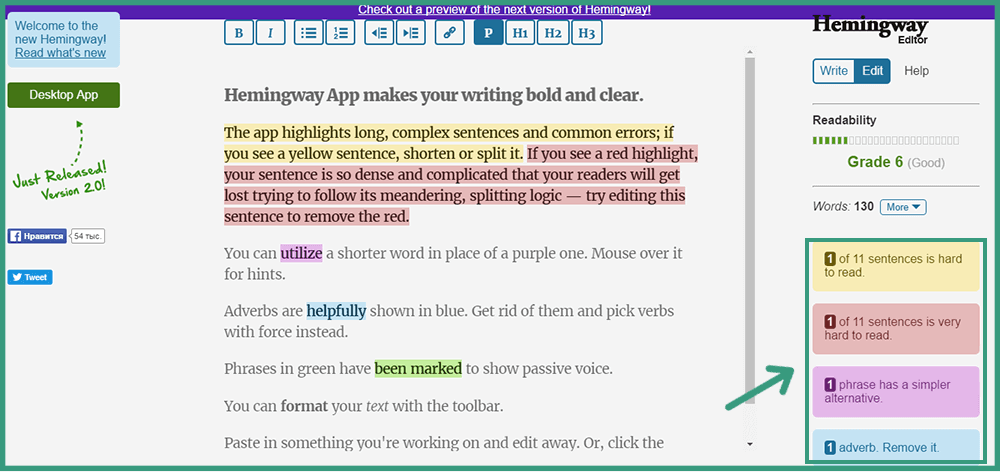
Another irreplaceable tool we use is Grammarly. It can check for contextual spelling, grammar, punctuation, sentence structure, and style. It also includes a Plagiarism checker that can compare your piece to online resources and tell you if there is any plagiarized content.
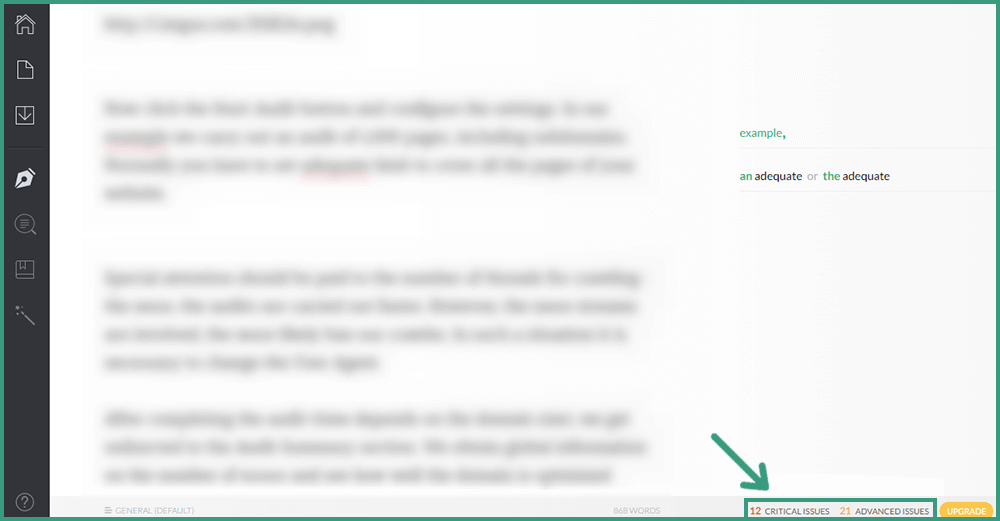
Optimizing Your Website’s Content for User Experience
When it comes to content optimization and updates for both users and search engines, here are some main points to consider:
- First, always plan, write, and deliver quality content as Google defines it;
- Your content – either product descriptions or lengthy blog posts – should always serve the users’ needs, solve a problem, answer their questions, and address their pain points;
- The content you create needs to be accessible, including to users with disabilities. It is something you need to consider for your entire website’s design and functioning;
- Your content, just as your entire website, needs to be credible and trustworthy;
- The content you deliver has to be well-structured, easy to navigate, understand, and use.
When you perform any content update and optimization, always keep your users in mind. Writing for people is what the search engines want from you too.
3. Technical Audit for Best Website Optimization
A technical audit includes measuring page speed, checking the site URLs, meta tags and titles, pages’ status, broken links, redirects, and backlinks, among others.
You need tools like Ahrefs, SEMrush, Serpstat, Appoptics etc.
In our example, we use Serpstat, as its design is very intuitive, and the price is very reasonable.
We selected hm.com as an example and carried out an audit of 1,000 pages, including subdomains. Normally you have to set an adequate limit to cover all pages of your website.
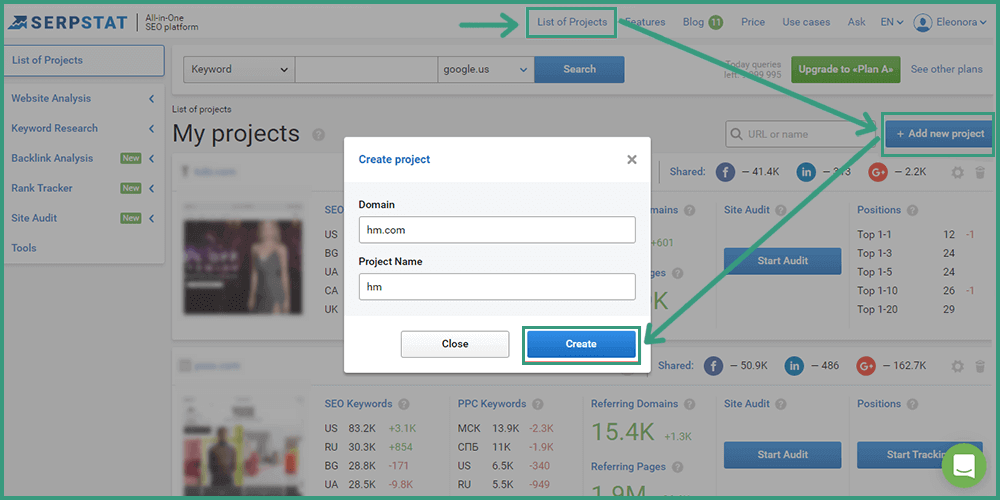
After completing the audit, we get a summary of the general condition of the site. All errors are divided into different groups depending on their solutions priority. The unique SDO score indicates how well the domain is optimized.
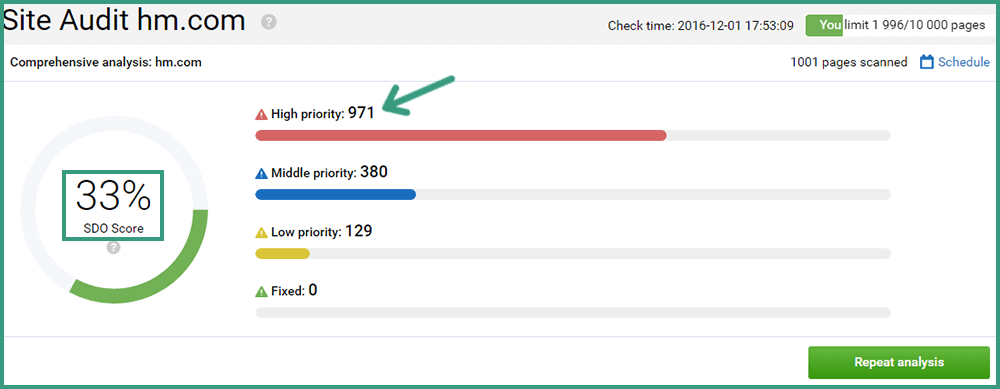

You can get the complete list of links to pages with all errors.
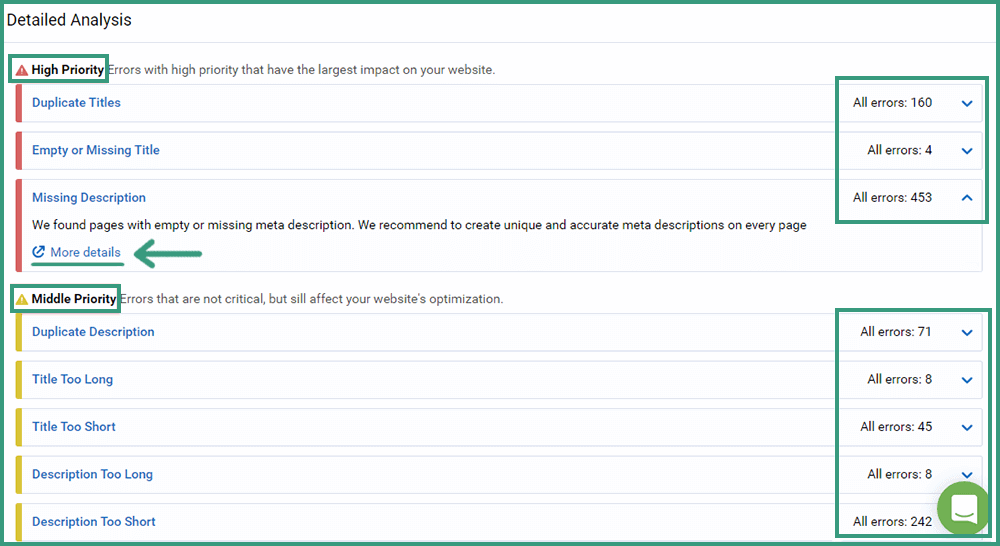
And an easy download list for further work.
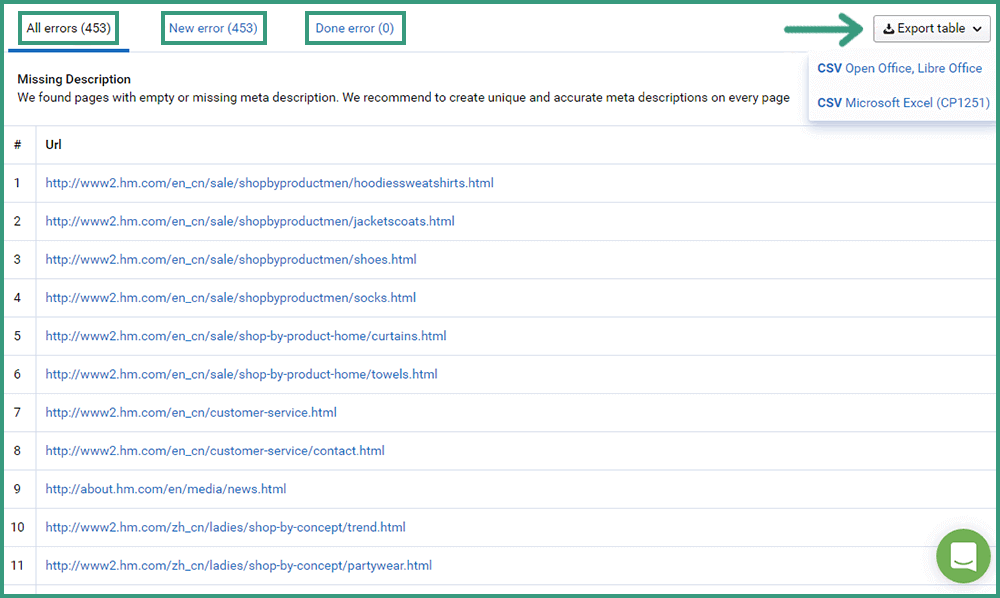
Also, don’t forget to check backlinks. They are one of the most important site ranking factors. Earning high-quality backlinks is also a complex process involving several backlinking strategies, but it is worth every second you spend on it.
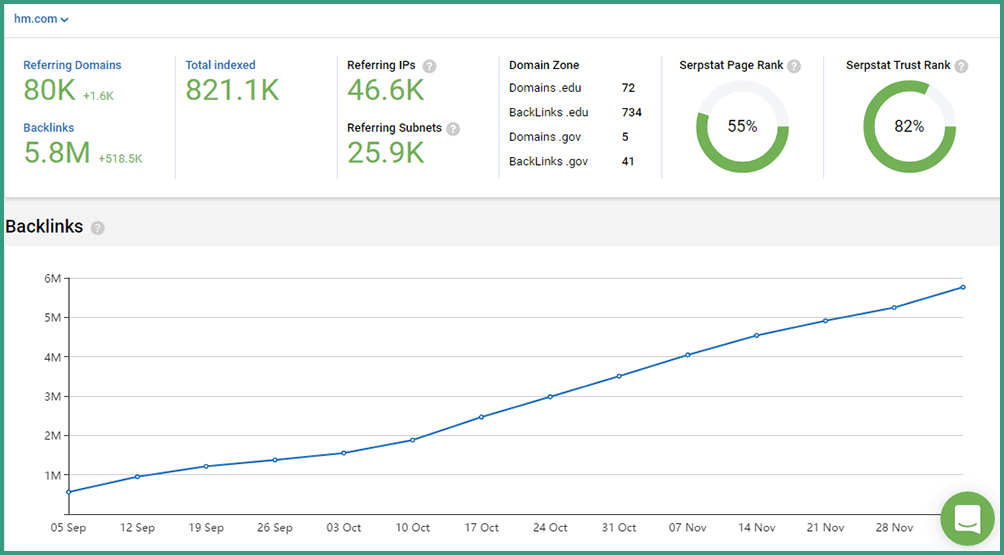
During a site audit and the website optimization process, it is necessary to consider:
- The number of incoming links;
- The anchor list – must be diverse;
- Types of links – links without anchors or from images are also valuable;
- Trust rank – it is better if the link sources were sites that already have some positive weight on the web;
- Outsmarting your competitors – tools like Ahrefs allow you to perform a complete website audit, list potential keywords, understand your competition, identify content gaps you might want to cover, and, thus, stay ahead in your niche.
Bottom Line
If you want to see your website at the top of SERP, you always have to keep a finger on the pulse. When the search engine algorithms update, your site must match the requirements. You also need to remain up to date with the latest trends in web design and correct errors on the site regularly.
These are the keys to the success and long-term operation of the site. Now that you know more about website optimization, it is time to start working on it.
Do you want a website covering all the major tech aspects described here, including page speed, mobile responsiveness, and UX-friendly design? Hurry up to create your website with Ucraft!

